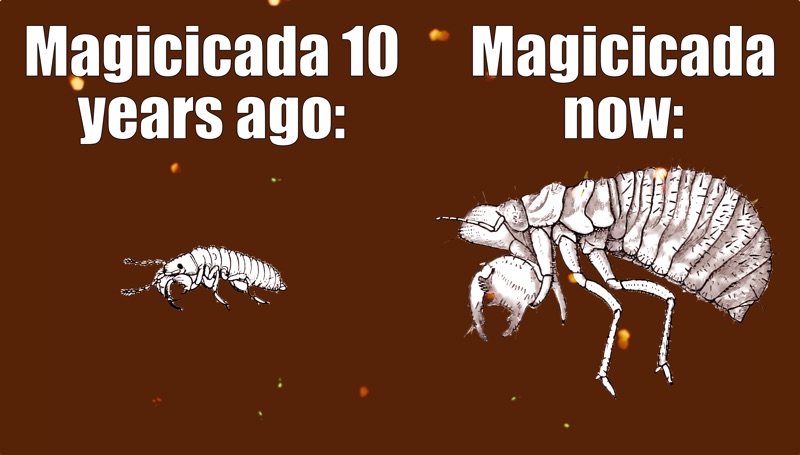
Magicicada septendecim aka 17-year Pharaoh Cicada.
Cicadas (Insecta: Hemiptera: Cicadidae) are insects, best known for the songs sung by most, but not all, male cicadas. Males sing by flexing their tymbals, which are drum-like organs found in their abdomens. Small muscles rapidly pull the tymbals in and out of shape. The cicada’s primarily hollow abdomen intensifies the sound.

An illustration of cicada tymbals from C.L. Marlatt’s The Periodical Cicada. c shows the muscles and tendons connected to the tymbals, and d & e shows the bending of the tymbal.
Female and some male cicadas will also make a sound by flicking their wings, but it isn’t the same as the sound for which cicadas are known. Listen to some of the songs cicadas sing.
Cicadas belong to the order Hemiptera, suborder Auchenorrhyncha, superfamily Cicadoidea and families Cicadidae (the vast majority of cicadas) or Tettigarctidae (only two species). There are five subfamilies of Cicadidae: Derotettiginae, Tibicininae, Tettigomyiinae, Cicadettinae, and Cicadinae. Leafhoppers, spittlebugs, and jumping plant lice are close relatives of the cicada. Hemiptera is different from other insects in that both the nymph and adult forms have a beak (aka rostrum), which they use to suck fluids called xylem from plants. This is how they both eat and drink.

A Magicicada drinking from a tree. Photo by Roy Troutman.
The body of a cicada is composed of a head, thorax & abdomen. The head features two antennae, two compound eyes, three simple eyes (ocelli), a clypeus that connects the beak to the head (the clypeus looks like the grill of a combustion vehicle). The thorax features two sets of wings (forewings & hindwings), six sets of legs, spiracles for breathing, opercula covering the tympana (“eardrums”), and in males of species that have them, tymbals & tymbal covers. The abdomen features tergites (dorsal) & sternites (ventral), more spiracles for breathing, and reproductive organs. Cicadidae and Tettigarctidae have major differences in anatomy, which you can learn about here.
The Latin root for the word for cicada is cicada. Cicadas are called semi in Japan, cigale in France, and cigarra in Spain. Names for cicadas in countries around the world. The pronunciation of the word cicada depends on your local dialect. You can say “si-Kah-da” or “si-kay-da”.

